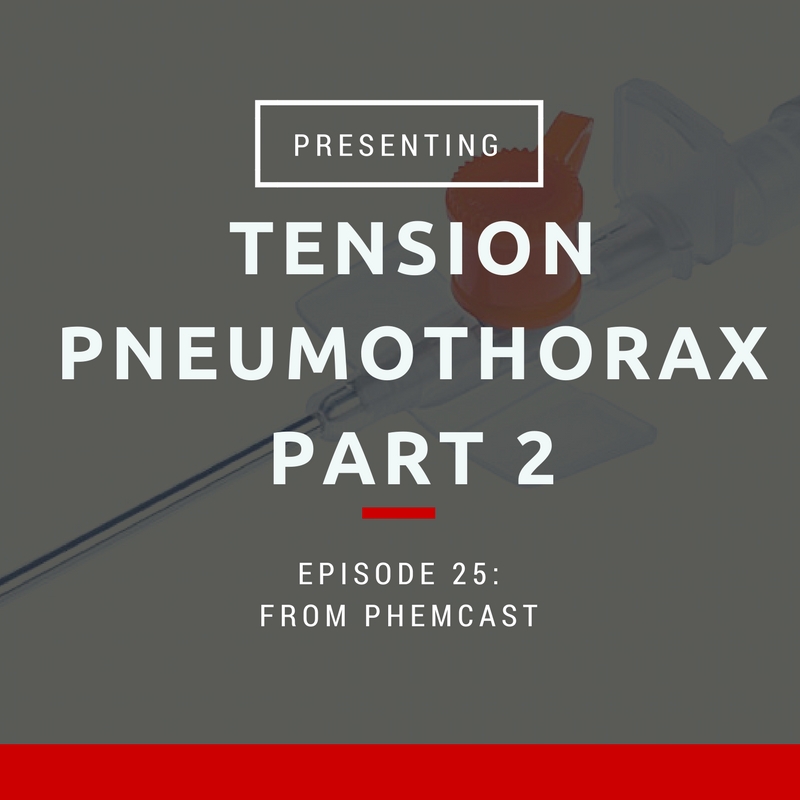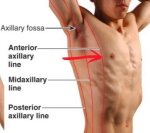Go offline with the Player FM app!
Episode 25: Tension pneumothorax 2
Manage episode 192665683 series 165883
 https://phemcast.files.wordpress.com/2017/12/tp2-final-11_11_2017-00-30.mp3
https://phemcast.files.wordpress.com/2017/12/tp2-final-11_11_2017-00-30.mp3
Where can you undertake decompression of a pneumothorax?


Be particularly careful when using the 2nd intercostal space mid-clavicular line that you are sufficiently lateral. For example, here are the locations identified as ‘2nd ICS mid clavicular line’ amongst 25 EM physicians in a 2005 EMJ paper.

From http://emj.bmj.com/content/22/11/788
The Three Kings: George Clooney’s recommended approach to decompression of a tension pneumothorax. Note – again please do not use this location!
Devices used for decompression:
Dressings available for covering an open pneumothorax +/- thoracostomy in a spontaneously breathing patient:



References
- Ball, C. G., Wyrzykowski, A. D., Kirkpatrick, A. W., Dente, C. J., Nicholas, J. M., Salomone, J. P., et al. (2010). Thoracic needle decompression for tension pneumothorax: clinical correlation with catheter length. Canadian Journal of Surgery Journal Canadien De Chirurgie, 53(3), 184–188.
- Barton, E. D., Epperson, M., Hoyt, D. B., Fortlage, D., & Rosen, P. (1995). Prehospital needle aspiration and tube thoracostomy in trauma victims: a six-year experience with aeromedical crews. The Journal of Emergency Medicine, 13(2), 155–163.
- Beckett, A., Savage, E., Pannell, D., Acharya, S., Kirkpatrick, A., & Tien, H. C. (2011). Needle Decompression for Tension Pneumothorax in Tactical Combat Casualty Care: Do Catheters Placed in the Midaxillary Line Kink More Often Than Those in the Midclavicular Line? The Journal of Trauma, 71, S408–S412. http://doi.org/10.1097/TA.0b013e318232e558
- Cullinane, D., Morris, J., Bass, J., & Rutherford, E. (2001). Needle thoracostomy may not be indicated in the trauma patient. Injury, 32, 749–752.
- Ferrie, E. P., Collum, N., & McGovern, S. (2005). The right place in the right space? Awareness of site for needle thoracocentesis. Emergency Medicine Journal, 22(11), 788–789. http://doi.org/10.1136/emj.2004.015107
- Fitzgerald, M., Mackenzie, C. F., Marasco, S., Hoyle, R., & Kossmann, T. (2008). Pleural decompression and drainage during trauma reception and resuscitation. Injury, 39(1), 9–20. http://doi.org/10.1016/j.injury.2007.07.021
- Givens, M. L., Ayotte, K., & Manifold, C. (2004). Needle thoracostomy: implications of computed tomography chest wall thickness. Academic Emergency Medicine : Official Journal of the Society for Academic Emergency Medicine, 11(2), 211–213. http://doi.org/10.1197/j.aem.2003.09.015
- Harcke, H. T., Mabry, R. L., & Mazuchowski, E. L. (2013). Needle thoracentesis decompression: observations from postmortem computed tomography and autopsy. Journal of Special Operations Medicine : a Peer Reviewed Journal for SOF Medical Professionals, 13(4), 53–58.
- Inaba, K., Branco, B. C., Eckstein, M., Shatz, D. V., Martin, M. J., Green, D. J., et al. (2011). Optimal positioning for emergent needle thoracostomy: a cadaver-based study. The Journal of Trauma, 71(5), 1099–103– discussion 1103. http://doi.org/10.1097/TA.0b013e31822d9618
- Inaba, K., Ives, C., McClure, K., Branco, B. C., Eckstein, M., Shatz, D., et al. (2012). Radiologic evaluation of alternative sites for needle decompression of tension pneumothorax. Archives of Surgery (Chicago, Ill : 1960), 147(9), 813–818. http://doi.org/10.1001/archsurg.2012.751
- Jadder, U., & McAuley, D. (2005). Transthoracic ultrasonography to diagnose pneumothorax in trauma. BestBETS.org, 1–3.
- Jones, R., & Hollingsworth, J. (2002). Tension pneumothoraces not responding to needle thoracocentesis. Emergency Medicine Journal, 19, 176–177.
- MD, A. R. M., MD, M. E. R., MD, C. S. C., & MD, J. L. M. (2015). Ultrasound determination of chest wall thickness: implications for needle thoracostomy. The American Journal of Emergency Medicine, 1–5. http://doi.org/10.1016/j.ajem.2010.06.030
- MD, B. B., & MD, J.-M. T. (2012). Initial Management and Resuscitation of Severe Chest Trauma. Emergency Medicine Clinics of NA, 30(2), 377–400. http://doi.org/10.1016/j.emc.2011.10.010
- MD, E. J. C., MD, C. H. C., BS, R. M., PHD, C. L. A., RDMS, C. A. K. M. M., RDMS, S. S. M., & RDMS, J. C. F. M. (2013). Ultrasound in Emergency Medicine. The Journal of Emergency Medicine, 44(1), 142–149. http://doi.org/10.1016/j.jemermed.2012.02.032
- Netto, F. A. C. S., Shulman, H., Rizoli, S. B., Tremblay, L. N., Brenneman, F., & Tien, H. (2008). Are needle decompressions for tension pneumothoraces being performed appropriately for appropriate indications? The American Journal of Emergency Medicine, 26(5), 597–602. http://doi.org/10.1016/j.ajem.2007.08.016
- Rathinam, S., Grobler, S., Bleetman, A., Kink, T., & Steyn, R. (2014). Evolved design makes ThoraQuik safe and user friendly in the management of pneumothorax and pleural effusion. Emergency Medicine Journal, 31(1), 59–64. http://doi.org/10.1136/emermed-2012-201821
- Rathinam, S., Quinn, D. W., Bleetman, A., Wall, P., & Steyn, R. S. (2011). Evaluation of ThoraQuik: a new device for the treatment of pneumothorax and pleural effusion. Emergency Medicine Journal, 28(9), 750–753. http://doi.org/10.1136/emj.2009.082297
- Sanchez, L. D., Straszewski, S., Saghir, A., Khan, A., Horn, E., Fischer, C., et al. (2011). Anterior versus lateral needle decompression of tension pneumothorax: comparison by computed tomography chest wall measurement. Academic Emergency Medicine : Official Journal of the Society for Academic Emergency Medicine, 18(10), 1022–1026. http://doi.org/10.1111/j.1553-2712.2011.01159.x
- Wax, D. B., & Leibowitz, A. B. (2007). Radiologic assessment of potential sites for needle decompression of a tension pneumothorax. Anesthesia and Analgesia, 105(5), 1385–8– table of contents. http://doi.org/10.1213/01.ane.0000282827.86345.ff
- Yamagiwa, T., Morita, S., Yamamoto, R., Seki, T., Sugimoto, K., & Inokuchi, S. (2012). Determination of the appropriate catheter length for needle thoracostomy by using computed tomography scans of trauma patients in Japan. Injury, 43(1), 42–45. http://doi.org/10.1016/j.injury.2010.11.022
- Zengerink, I., Brink, P. R., Laupland, K. B., Raber, E. L., Zygun, D., & Kortbeek, J. B. (2008). Needle thoracostomy in the treatment of a tension pneumothorax in trauma patients: what size needle? The Journal of Trauma, 64(1), 111–114. http://doi.org/10.1097/01.ta.0000239241.59283.03
48 episodes
Manage episode 192665683 series 165883
 https://phemcast.files.wordpress.com/2017/12/tp2-final-11_11_2017-00-30.mp3
https://phemcast.files.wordpress.com/2017/12/tp2-final-11_11_2017-00-30.mp3
Where can you undertake decompression of a pneumothorax?


Be particularly careful when using the 2nd intercostal space mid-clavicular line that you are sufficiently lateral. For example, here are the locations identified as ‘2nd ICS mid clavicular line’ amongst 25 EM physicians in a 2005 EMJ paper.

From http://emj.bmj.com/content/22/11/788
The Three Kings: George Clooney’s recommended approach to decompression of a tension pneumothorax. Note – again please do not use this location!
Devices used for decompression:
Dressings available for covering an open pneumothorax +/- thoracostomy in a spontaneously breathing patient:



References
- Ball, C. G., Wyrzykowski, A. D., Kirkpatrick, A. W., Dente, C. J., Nicholas, J. M., Salomone, J. P., et al. (2010). Thoracic needle decompression for tension pneumothorax: clinical correlation with catheter length. Canadian Journal of Surgery Journal Canadien De Chirurgie, 53(3), 184–188.
- Barton, E. D., Epperson, M., Hoyt, D. B., Fortlage, D., & Rosen, P. (1995). Prehospital needle aspiration and tube thoracostomy in trauma victims: a six-year experience with aeromedical crews. The Journal of Emergency Medicine, 13(2), 155–163.
- Beckett, A., Savage, E., Pannell, D., Acharya, S., Kirkpatrick, A., & Tien, H. C. (2011). Needle Decompression for Tension Pneumothorax in Tactical Combat Casualty Care: Do Catheters Placed in the Midaxillary Line Kink More Often Than Those in the Midclavicular Line? The Journal of Trauma, 71, S408–S412. http://doi.org/10.1097/TA.0b013e318232e558
- Cullinane, D., Morris, J., Bass, J., & Rutherford, E. (2001). Needle thoracostomy may not be indicated in the trauma patient. Injury, 32, 749–752.
- Ferrie, E. P., Collum, N., & McGovern, S. (2005). The right place in the right space? Awareness of site for needle thoracocentesis. Emergency Medicine Journal, 22(11), 788–789. http://doi.org/10.1136/emj.2004.015107
- Fitzgerald, M., Mackenzie, C. F., Marasco, S., Hoyle, R., & Kossmann, T. (2008). Pleural decompression and drainage during trauma reception and resuscitation. Injury, 39(1), 9–20. http://doi.org/10.1016/j.injury.2007.07.021
- Givens, M. L., Ayotte, K., & Manifold, C. (2004). Needle thoracostomy: implications of computed tomography chest wall thickness. Academic Emergency Medicine : Official Journal of the Society for Academic Emergency Medicine, 11(2), 211–213. http://doi.org/10.1197/j.aem.2003.09.015
- Harcke, H. T., Mabry, R. L., & Mazuchowski, E. L. (2013). Needle thoracentesis decompression: observations from postmortem computed tomography and autopsy. Journal of Special Operations Medicine : a Peer Reviewed Journal for SOF Medical Professionals, 13(4), 53–58.
- Inaba, K., Branco, B. C., Eckstein, M., Shatz, D. V., Martin, M. J., Green, D. J., et al. (2011). Optimal positioning for emergent needle thoracostomy: a cadaver-based study. The Journal of Trauma, 71(5), 1099–103– discussion 1103. http://doi.org/10.1097/TA.0b013e31822d9618
- Inaba, K., Ives, C., McClure, K., Branco, B. C., Eckstein, M., Shatz, D., et al. (2012). Radiologic evaluation of alternative sites for needle decompression of tension pneumothorax. Archives of Surgery (Chicago, Ill : 1960), 147(9), 813–818. http://doi.org/10.1001/archsurg.2012.751
- Jadder, U., & McAuley, D. (2005). Transthoracic ultrasonography to diagnose pneumothorax in trauma. BestBETS.org, 1–3.
- Jones, R., & Hollingsworth, J. (2002). Tension pneumothoraces not responding to needle thoracocentesis. Emergency Medicine Journal, 19, 176–177.
- MD, A. R. M., MD, M. E. R., MD, C. S. C., & MD, J. L. M. (2015). Ultrasound determination of chest wall thickness: implications for needle thoracostomy. The American Journal of Emergency Medicine, 1–5. http://doi.org/10.1016/j.ajem.2010.06.030
- MD, B. B., & MD, J.-M. T. (2012). Initial Management and Resuscitation of Severe Chest Trauma. Emergency Medicine Clinics of NA, 30(2), 377–400. http://doi.org/10.1016/j.emc.2011.10.010
- MD, E. J. C., MD, C. H. C., BS, R. M., PHD, C. L. A., RDMS, C. A. K. M. M., RDMS, S. S. M., & RDMS, J. C. F. M. (2013). Ultrasound in Emergency Medicine. The Journal of Emergency Medicine, 44(1), 142–149. http://doi.org/10.1016/j.jemermed.2012.02.032
- Netto, F. A. C. S., Shulman, H., Rizoli, S. B., Tremblay, L. N., Brenneman, F., & Tien, H. (2008). Are needle decompressions for tension pneumothoraces being performed appropriately for appropriate indications? The American Journal of Emergency Medicine, 26(5), 597–602. http://doi.org/10.1016/j.ajem.2007.08.016
- Rathinam, S., Grobler, S., Bleetman, A., Kink, T., & Steyn, R. (2014). Evolved design makes ThoraQuik safe and user friendly in the management of pneumothorax and pleural effusion. Emergency Medicine Journal, 31(1), 59–64. http://doi.org/10.1136/emermed-2012-201821
- Rathinam, S., Quinn, D. W., Bleetman, A., Wall, P., & Steyn, R. S. (2011). Evaluation of ThoraQuik: a new device for the treatment of pneumothorax and pleural effusion. Emergency Medicine Journal, 28(9), 750–753. http://doi.org/10.1136/emj.2009.082297
- Sanchez, L. D., Straszewski, S., Saghir, A., Khan, A., Horn, E., Fischer, C., et al. (2011). Anterior versus lateral needle decompression of tension pneumothorax: comparison by computed tomography chest wall measurement. Academic Emergency Medicine : Official Journal of the Society for Academic Emergency Medicine, 18(10), 1022–1026. http://doi.org/10.1111/j.1553-2712.2011.01159.x
- Wax, D. B., & Leibowitz, A. B. (2007). Radiologic assessment of potential sites for needle decompression of a tension pneumothorax. Anesthesia and Analgesia, 105(5), 1385–8– table of contents. http://doi.org/10.1213/01.ane.0000282827.86345.ff
- Yamagiwa, T., Morita, S., Yamamoto, R., Seki, T., Sugimoto, K., & Inokuchi, S. (2012). Determination of the appropriate catheter length for needle thoracostomy by using computed tomography scans of trauma patients in Japan. Injury, 43(1), 42–45. http://doi.org/10.1016/j.injury.2010.11.022
- Zengerink, I., Brink, P. R., Laupland, K. B., Raber, E. L., Zygun, D., & Kortbeek, J. B. (2008). Needle thoracostomy in the treatment of a tension pneumothorax in trauma patients: what size needle? The Journal of Trauma, 64(1), 111–114. http://doi.org/10.1097/01.ta.0000239241.59283.03
48 episodes
All episodes
×Welcome to Player FM!
Player FM is scanning the web for high-quality podcasts for you to enjoy right now. It's the best podcast app and works on Android, iPhone, and the web. Signup to sync subscriptions across devices.








